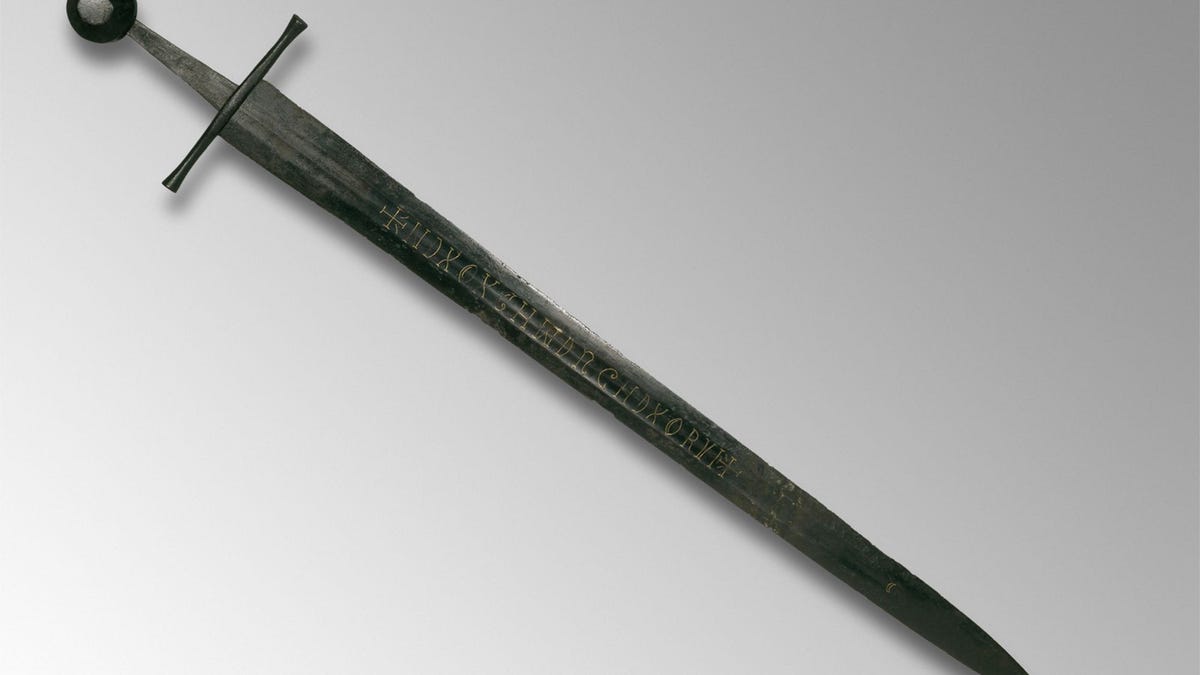British Library asks for help deciphering a medieval sword
An as-yet indecipherable inscription on a sword dating back to 800 years ago has researchers at the British Library flummoxed.
A sword on display at the British Library has an 800-year-old mystery engraved on its blade.
Dating back to between 1250 and 1330 AD, the sword was discovered in the east of England, in the River Witham near Lincoln, in the 19th century. The sword is a particularly fine double-edged steel weapon of English design. It was most likely forged in Germany and belonged to a wealthy man or a knight.
The hilt is cross-shaped, which is normal for swords from this period of the Middle Ages, and is heavy enough to have cloven a man's head in twain if swung with sufficient strength.
But the sword, on loan to the library from the British Museum, does have a couple of highly unusual features. Down the centre of the blade, it has two grooves known as fullers, where most blades only have one. On one side, it also bears an inscription:
+NDXOXCHWDRGHDXORVI+
It's not the presence of the inscription that has researchers nonplussed, but its content: Experts don't know what the inscription means.
"An intriguing feature of this sword is an as yet indecipherable inscription, found along one of its edges and inlaid in gold wire," wrote curator Julian Harrison on the library's blog. "It has been speculated that this is a religious invocation, since the language is unknown."
The River Witham sword is not unique in this. According to archaeologist Marc van Hasselt of Utrecht University and Hastatus Heritage Consultancy in the Netherlands, inscribed swords were "all the rage" in Europe at the turn of the 13th century, and religious invocations would have made sense.
He has studied around a dozen such swords. Most notable was a sword found in Alphen aan den Rijn in the Netherlands, likewise bearing an indecipherable inscription, this time on both sides of the blade:
+BENEDOXOFTISSCSDRRISCDICECMTINIUSCSDNI+
+DIOXMTINIUSESDIOMTINIUSCSDICCCMTDICIIZISI+
"There is some debate on the language used in the inscriptions. But looking at the other European finds, it seems most likely that this language is Latin. This makes sense in the context of 13th-century Europe, as Latin was the international language of choice (like English is today)," van Hasselt wrote.
"To elaborate, let's compare the River Witham sword to the sword from Alphen: Both start with some sort of invocation. On the River Witham sword, it is NDXOX, possibly standing for Nostrum Dominus (our Lord) or Nomine Domini (name of the Lord) followed by XOX. On the sword from Alphen, the starting letters read BENEDOXO. Quite likely, this reads as Benedicat (A blessing), followed by OXO. Perhaps these letter combinations -- XOX and OXO -- refer to the Holy Trinity. On the sword from Alphen, one letter combination is then repeated three times: MTINIUSCS, which I interpret as Martinius Sanctus -- Saint Martin. Perhaps a saint is being invoked on the River Witham sword as well?"
Most guesses put forth on the blog post also agree with the idea that it could be Latin, with some readers suggesting the letters, or some of the letters, could be acronyms.
If you want to give it a shot, head on over to the British Library's blog post and post your hypothesis in the comments.
If you want to see the sword itself, it's on display as part of the exhibition Magna Carta: Law, Liberty, Legacy at the British Library in London until September 1.


